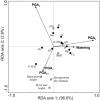Effects of γ-polyglutamic acid on grassland sandy soil properties and plant functional traits exposed to drought stress
- PMID: 38355917
- PMCID: PMC10866894
- DOI: 10.1038/s41598-024-54459-1
Effects of γ-polyglutamic acid on grassland sandy soil properties and plant functional traits exposed to drought stress
Abstract
The current study provides field experimental data that support the use of γ-polyglutamic acid (γ-PGA) in drought stress and proposes its application in grassland management. We hypothesized that water treatment combined with PGA application to sandy soil would reduce drought stress in grasslands more effectively than watering alone. A randomized block design was used, with three replicate watering blocks (no watering, weekly watering, and monthly watering) and PGA treatments at four different concentrations (0%, 0.3%, 1%, and 2% PGA). The results showed that PGA acts as a biostimulant, alleviating the effects of stress in plants by: (1) increasing the availability of ions, especially K+, Zn2+, Mn2+, Fe2+/3+, Ca2+, and Mg2+, as well as N-NH4+, and N-NO3-, (2) elongating plant roots, (3) increasing the aboveground biomass, (4) improving the resprouting capacity of the dominant grass Nardus stricta, and (5) improving the regeneration of dicotyledons. In the case of meadows on sandy soils, the use of low PGA concentrations (0.3% or 1%) was the most beneficial for the availability of macro- and microelements and improving the functional traits of plants. Irrigation had a greater effect than using PGA only for the dicotyledon to monocotyledon ratio.
© 2024. The Author(s).
Conflict of interest statement
TS, EJ, BS, AZW, and EZ declare their authorship of the patent application (P.446020) where some of the presented results were included.
Figures







Similar articles
-
Effects of poly-γ-glutamic acid and poly-γ-glutamic acid super absorbent polymer on the sandy loam soil hydro-physical properties.PLoS One. 2021 Jan 12;16(1):e0245365. doi: 10.1371/journal.pone.0245365. eCollection 2021. PLoS One. 2021. PMID: 33434231 Free PMC article.
-
Phytoremediation of secondary saline soil by halophytes with the enhancement of γ-polyglutamic acid.Chemosphere. 2021 Dec;285:131450. doi: 10.1016/j.chemosphere.2021.131450. Epub 2021 Jul 7. Chemosphere. 2021. PMID: 34246095
-
Poly-γ-glutamic acid enhanced the drought resistance of maize by improving photosynthesis and affecting the rhizosphere microbial community.BMC Plant Biol. 2022 Jan 3;22(1):11. doi: 10.1186/s12870-021-03392-w. BMC Plant Biol. 2022. PMID: 34979944 Free PMC article.
-
No shift to a deeper water uptake depth in response to summer drought of two lowland and sub-alpine C₃-grasslands in Switzerland.Oecologia. 2015 Jan;177(1):97-111. doi: 10.1007/s00442-014-3092-6. Epub 2014 Oct 2. Oecologia. 2015. PMID: 25273953
-
Can permanent grassland soils with elevated organic carbon buffer negative effects of more persistent precipitation regimes on forage grass performance?Sci Total Environ. 2024 Mar 25;918:170623. doi: 10.1016/j.scitotenv.2024.170623. Epub 2024 Feb 4. Sci Total Environ. 2024. PMID: 38320706
Cited by
-
Potassium silica nanostructure improved growth and nutrient uptake of sorghum plants subjected to drought stress.Front Plant Sci. 2024 Jul 17;15:1425834. doi: 10.3389/fpls.2024.1425834. eCollection 2024. Front Plant Sci. 2024. PMID: 39086913 Free PMC article.
References
-
- Bever JD. Feedback between plants and their soil communities in an old field community. Ecology. 1994;75:1965–1977. doi: 10.2307/1941601. - DOI
-
- Wagg C, Boller B, Schneider S, Widmer F, van der Heijden MGA. Intraspecific and intergenerational differences in plant-soil feedbacks. Oikos. 2015;124:994–1004. doi: 10.1111/oik.01743. - DOI
MeSH terms
Substances
Grants and funding
LinkOut - more resources
Full Text Sources
Miscellaneous

